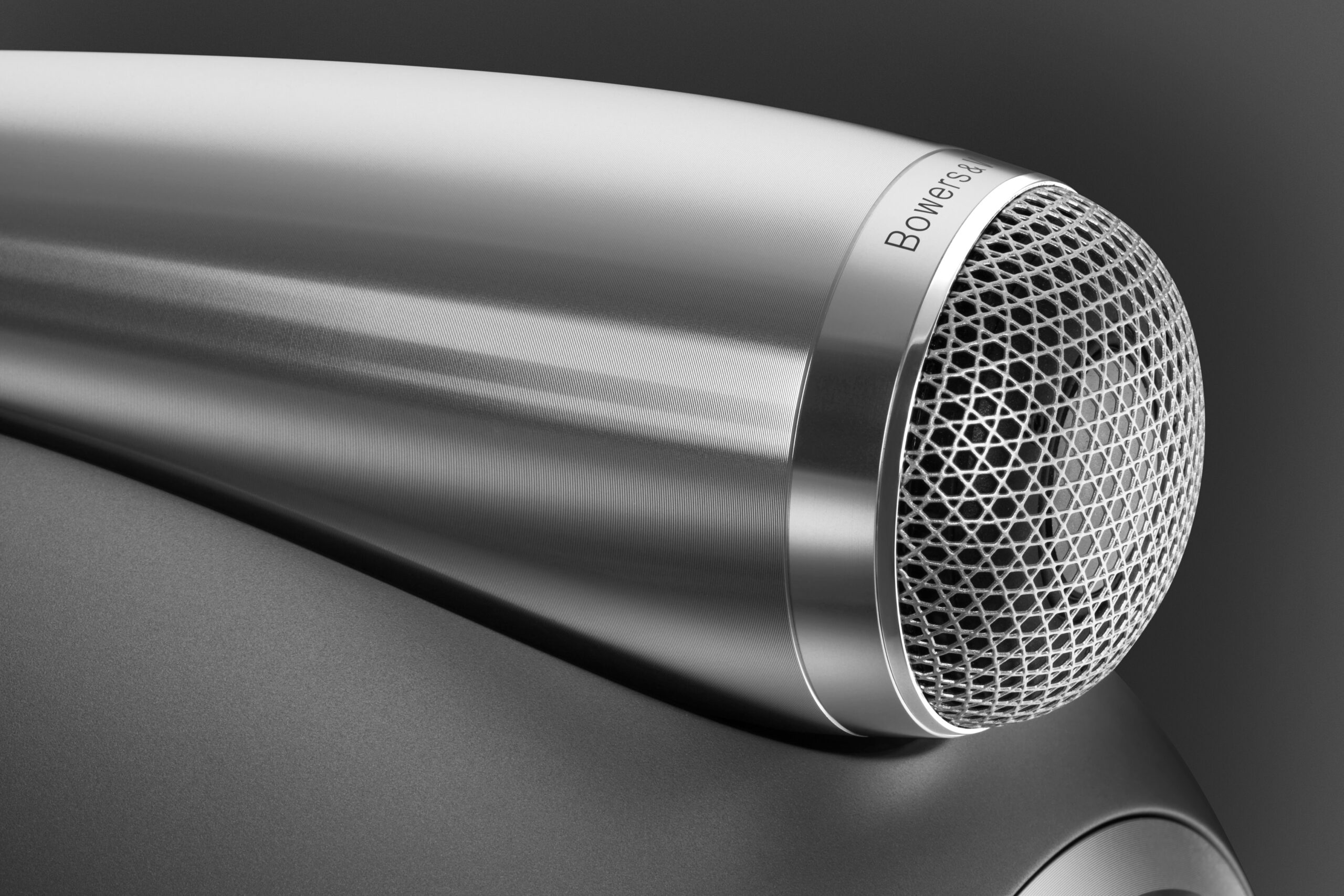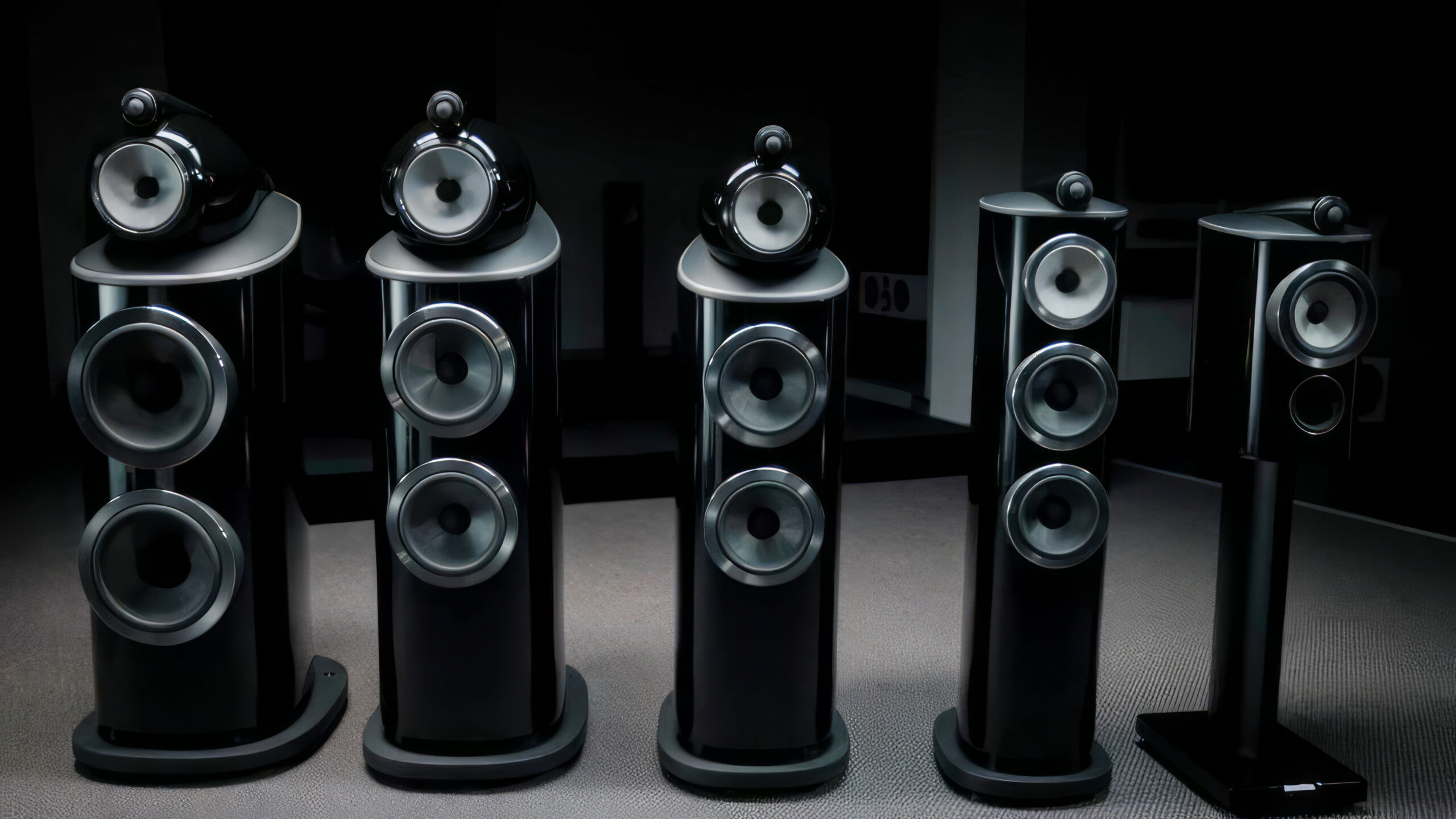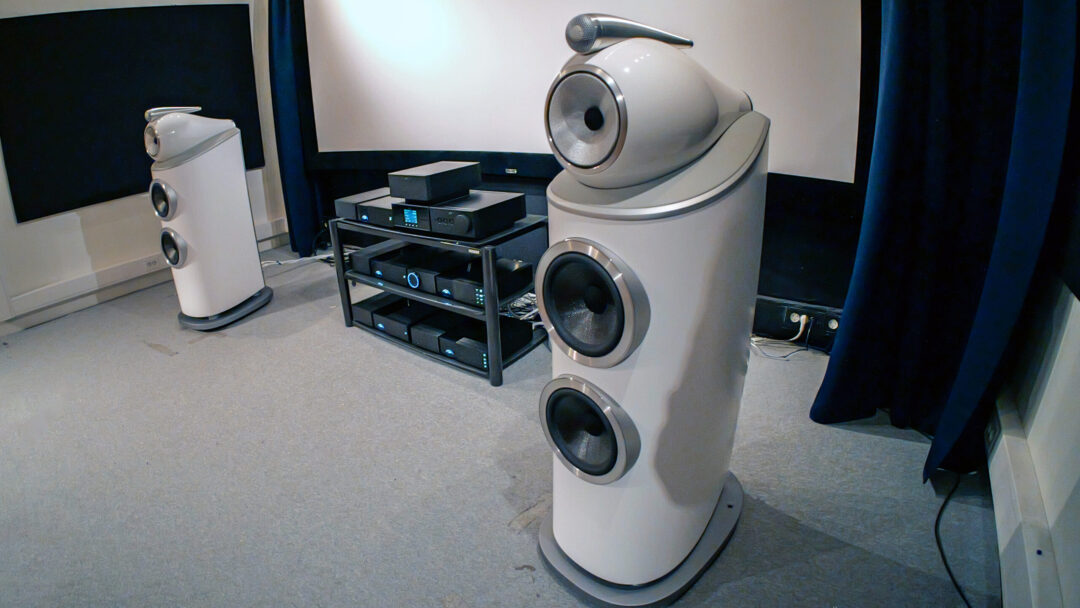What do you get when one of the world’s leading speaker manufacturers embarks on a project to create the ultimate speaker series? The answer is the Bowers & Wilkins 800 D4 Series. The top-of-the-range 801 D4 is the latest addition to the lineage of the iconic speaker that entered the legendary Abbey Road Studios almost 45 years ago and immediately set a new standard for studio sound.
One step down from the giant 801 D4 top model is the 802 D4. The D4 stands for the fourth generation diamond tweeter. However, it’s not much smaller, only three millimetres lower and just under four centimetres narrower. Each speaker weighs 12.5 kilos less than the 801 D4, but with a weight of 88 kilos each, your back will still take a beating. Luckily, there are wheels underneath so they can be rolled into place. That said, I wouldn’t roll them around on parquet floors as the small wheels can make marks in the floors.

Once the speakers are in place, you can screw down the spikes that are already mounted on the underside of the speakers. Brilliant!
Along with the other models, the 802 D4 epitomises B&W’s ultimate ambition – to bring the listener as close to the original recording as possible. To achieve this, B&W has pushed the boundaries of what is technically possible, and the result is an uncompromising design that stands up to the most critical scrutiny. You won’t find a crooked joint or screw anywhere, everything is sanded, polished and assembled to perfection.
This is ultra high-end that will make you cry. Of joy, of feeling the perfect magic of music. And of sadness, because you can never afford it.

The cabinet design
The first thing you notice when you see the 802 D4 is its iconic design. The look is dictated by acoustic considerations, with the main cabinet having an almost perfect teardrop shape when viewed from above. This is to direct all sound waves away from each other and minimise diffraction.
Inside this teardrop-shaped shell we find B&W’s custom-engineered Matrix skeleton. It’s a network of intricate, interlocking panels that strengthen the cabinet walls in all directions and reduce resonances. In addition, it is reinforced with aluminium at critical stress points. According to B&W, the D4 Series Matrix construction is their most advanced ever.

Turbine Head
Above the woofers sits the separate midrange cabinet, which B&W calls the Turbine Head. The housing is made of solid aluminium and has undergone extensive bracing and damping to avoid turbulence and standing sound waves. In the D4 version, the midrange cabinet has also been given even better acoustic decoupling from the bass chamber.
At the top is a shiny aluminium ‘torpedo’ that houses the tweeter – a separate unit designed to isolate the sensitive diamond dome from the rest of the cabinet. The tweeter chamber is tapered backwards to absorb energy from the back of the diaphragm and minimise diffraction.
Video above: From a factory tour during the production of the 800 D3 series. Video: Geir Gråbein Nordby
Proprietary drivers
The drivers in the 802 D4 are custom-made and deeply rooted in B&W engineering. The midrange uses their unique, proprietary Continuum diaphragm suspended in a so-called biomimetic damping system, meaning it has properties that mimic those found in nature. In this case, it’s all about reducing unwanted air pressure differences, culminating in what Bowers & Wilkins claims is “the most realistic midrange reproduction ever”.
The diamond tweeter has been a B&W trademark in recent years and represents perhaps the purest form of high technology in loudspeakers. With exceptional stiffness and low mass, it is designed to deliver a razor-sharp yet clean and uncoloured treble all the way up to 28 kHz, measured linearly with only -3 dB roll-off.
At the bottom we find two 8-inch woofers with B&W’s proprietary Aerofoil cone. This features a sandwich construction with carbon fibre on top of a rigid foam material and a curvature designed to minimise resonances and ensure the cleanest possible piston movement.
It’s all topped off with a customised crossover with tailor-made capacitors from Mundorf. These sit inside a solid aluminium backplate with cooling fins that keep the crossover components at a stable temperature.

The sound of the B&W 802 D4
So how does this technological tour de force sound? In short: soundless. A frequency range that extends linearly from 17 to 28,000 Hz and a sensitivity of a whopping 90 dB testify that this is a highly stable and efficient design that shouldn’t need many amplifier watts to give a good sense of what it can do.
I’ve had the speakers for a while, and I’ve had different equipment in and out of the door during the test period.
One interesting electronics combination I got to test was the Gold Note DS-10 EVO music streamer with separate power supply and with its variable audio output directly connected to the exceptionally clean-sounding Mola Mola Perca power amplifier.
The sound with this setup is exemplary clean, as if cut with a laser. Perfection wherever you focus in the soundstage, never harsh or coarse-grained. The attention to detail in the Madonna cover Like a Prayer performed by King Hannah is breathtaking. Her voice pours out of the speakers, completely disappearing. Like a hologram hanging in front of me in space. The drone-like bass notes placed to the right of the soundstage are so detailed and resonant that it feels as if the bass notes are woven layer by layer.
The percussion is reproduced with strength and openness, especially in the midrange, but the coherence between the frequency ranges is also impeccable.
The only thing I could wish for is more punch and dynamics, because after all, these are big speakers that should be able to punch when needed (although listening to music is usually about completely different qualities, which these speakers truly possess).

With Naim
A switch to the Naim Classic 300 series electronics provides significantly better physicality. 175 watts might not mean much if it was anything other than Naim. But when we know that Naim with 90 watts can do what most competitors need 200 watts to do (Naim often delivers a huge peak power, which is certainly relevant), it’s clear that the NAP 350 mono power amplifier has the power to make a difference.
The Naim setup with a separate power supply for the NSS 333 streamer costs about the same as a pair of 802 D4s, so price-wise it’s a very reasonable combination.
And it’s definitely a good combination in terms of sound too. Because when you take the extreme resolution and add a good dose of physics, the rhythms of Lola Young’s trip-hop song Stream of Consciousness become completely different. The percussion takes on a completely different physicality and there’s more meat to Lola’s voice down the register.
With Hegel’s most expensive
Together with Hegel’s most expensive amplifier sets P30A and H30A, the stage is set for an even more dynamic and physical reproduction of the soundstage. And that’s exactly what you get. At the same time, it’s also clear that the speakers have a built-in brake pad in the bass. More specifically in the mid-bass. Because while the speakers undeniably go deep and the bass is reproduced with a level of detail you wouldn’t have thought possible, the speakers are quite far from conveying a snare drum with the same kick that, for example, KEF Blade One Meta is capable of. The extreme physicality of the rhythms they created in the test room two years ago is a feeling I’ve been chasing ever since. And you can expect a little more midrange punch with speakers as big and heavy as the 802 D4.

The sensible middle model?
The even more expensive top model, the 801 D4, has a similar tendency, although to a lesser degree. One notch below is the 803 D4. Which again has a slightly lighter bass than the 802, but otherwise performs very well. To me, it seems like the most sensible purchase of the three, but if you have a larger room, the 802 D4 is not that much more expensive in percentage terms. With the same magic throughout the entire range, just not with the very deepest frequencies in the bass. But not much less punch in the midrange either.
But let there be no doubt: no matter which 800 D4 Series speaker you choose, the music is delivered with extremely low distortion, allowing the music to breathe freely through the most complex passages. You hear new nuances and details every time you listen. It’s truly addictive.

Competitors
If you’re fortunate enough to be in this price range when looking for your next speakers, there are many to woo your wallet. The KEF Blade Two Meta, little brother to the Blade One Meta, costs the same. If you’re looking for brutal dynamics and sonic gut punch, they’re a better choice. You also get extremely good dispersion, so the sound is very homogeneous no matter where you sit in relation to the speaker. But the 802 D4 has a clear advantage when it comes to airiness, transparency and resolution. The KEFs have a pronounced sense of presence – though it can cross over into a nasal reproduction of vocals.
Then there’s the Focal Sopra No3, which sounds grand and potent. More powerful in the midrange than the 802 D4, but more exaggerated sibilance.
The Audiovector R6 Arreté is also a speaker to consider. They sound great while being even more easily driven than the 802 D4. Far from the same impression of build quality, but a fabulous speaker nonetheless.
Then there’s the Vivid Audio Kaya 90. With its distinctive rounded appearance, it has more similarities than differences to Bowers & Wilkins. Although visually they are very different. Chief designer Laurence Dickie was responsible for B&W’s Nautilus snail-shaped speaker back in 1993 and came up with the principle of the conical tubes behind the drivers. The same principle is used in Vivid Audio’s speakers, just shaped differently on the inside of the cabinet.
The Kaya 90 sounds as clean as it is homogeneous. It’s much lighter in weight than the 802 D4, but sonically they’re not that different. The B&W speakers do go much deeper in the bass, but I would definitely listen to the Kaya 90 as well.

Conclusion
Is the B&W 802 D4 the perfect speaker? Well, the question is, does such a speaker exist? I don’t think it does. But it certainly pushes the boundaries of what is possible to achieve in speaker design today. Especially when it comes to purity and openness. The speaker combines B&W’s most advanced technology with top-shelf materials in a distinctive design where function and form go hand in hand.
The 802 D4 may not be the speaker model for everyone. Both price and size are aimed at the most dedicated enthusiasts. But for those who aspire to the ultimate in speaker art and have the means to realise it, the 802 D4 represents some of the best you can get. A speaker that doesn’t just play music, but fills your soul with it.
Personally, I miss more punch and energy in the midrange. But I’m open to the idea that there’s something wrong with me.

We think
Infinite details, in an enormously large and clean soundstage. The mid-bass lacks punch.
31000 €
Specifications
- Type: 3-way bass reflex
- Woofer: 2 x 20 cm (8″) Aerofoil
- Midrange: 15 cm (6″) Continuum FST
- Tweeter: 2.5 cm (1″) diamond
- Sensitivity: 90 dB (2.83V, 1m)
- Impedance: 8 Ohm (min. 3 Ohm)
- Frequency range: 17-28,000 Hz (-3dB) / 14-35,000 Hz (-6dB)
- Crossover frequencies: Not specified
- Recommended amplifier power: 50-500 W
- Dimensions (HxWxD): 121.8 cm x 41.3 cm x 60.2 cm
- Weight: 88.1 kg
- Colours: High gloss black, white, rosewood, walnut
- Web: bowerswilkins.com

